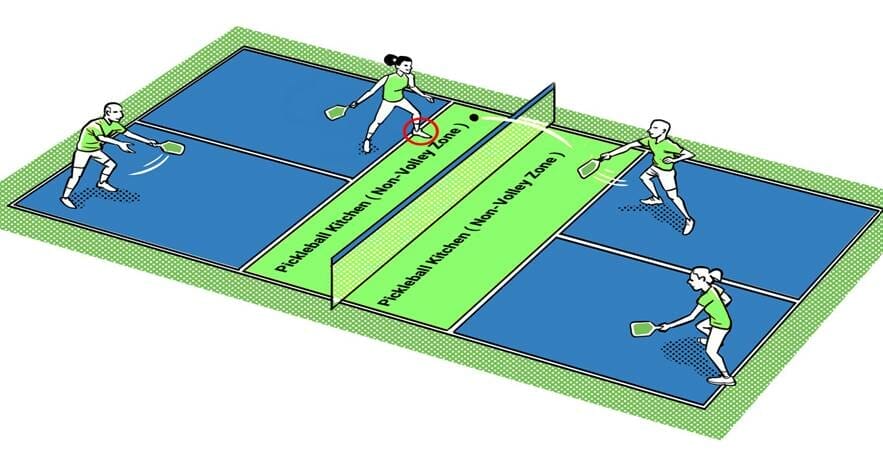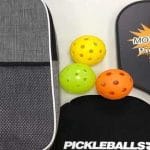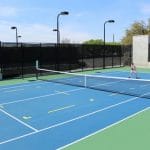The first time I heard the word “kitchen,” I thought it would be something related to cooking. At the same time, I wondered what to cook with a paddle and porous ball containing 26-40 round holes.
When I was a newbie, I had no clue about the court divisions and rules. So, I made silly mistakes out of my ignorance. After going through error and trail, I decided to dive in-depth to know the pickleball’s terms and rules.
The moment I found out exactly what the kitchen stands for in pickleball, I was like, “Oh-my-gosh.”
Although it was ok for a newbie to make mistakes, for your convenience, I will try to give you an insight into why it is called the kitchen in pickleball? Thus, you can start this fun game without any hesitation.
The Kitchen Area
Before telling you about the kitchen area, it would be better to introduce you to the two terms: “Volley” and “Non-volley. “
The term volley means you strike the ball out of the air before it bounces to the ground during the rally.
Non-volley includes the flat playing
The surface where you can’t hit any ball out of the air. Simply, it is another name of the kitchen area.
According to the USAPA rulebook, the total area of the pickleball (racquet sport) court size should be measured 20 x 44 feet. The court is then divided into equal halves. The kitchen area starts 7 feet behind from the net, on each side, and sideline to sideline (court denoting in and out of bounds).
This “sports share features” like the tennis and badminton court since it also has a backcourt near the baseline.
Furthermore, there is a centerline extending from kitchen to baseline. It’s almost 9ft 11inches away from the outside chalk line.
The Kitchen Rules – What you can DO and DON’T
That being said, if you can’t tolerate the heat, stay out of the kitchen. Although everyone has heard this, it goes well with the paddle ball sport.
Before jumping into the ground, you should go through these proper pickleball rules to know what you can and can’t do in the kitchen area.
The USAPA and IFP (International Federation for Pickleball) interpret official ruling by maintaining the sport’s traditional nature and character. So, it is not so difficult to follow.
Let’s shift forward…..
Non-Volley Zone Rules
In the following, you will get a glimpse of the no volley zone Rule Clarification Information:
- You cannot make a volley shot in two positions, one is when you’re standing in the non-volley zone, and the other is when you are touching the kitchen line.
- You should keep your feet outside of the non-volley zone before and after you hit.
- Must keep your body parts out of the line while you are volleying.
- Even your accessories should not come in contact with the zone during volleying.
Over the Line Rules
When you are ready or start volleying you aren’t allowed to touch the non-volley zone.
By any chance you touch the line unconsciously, it will be considered as a fault. Even your key ring or cap or any accessories you are wearing cannot cross or touch the line.
For this reason, even after the ball hits, the player or racket will not cross the non-volley line. It’s because of the speed from the volley.
Partner Rules
First off, while playing the volley, your partner can play a vital role by grabbing you for not to go in the zone, especially when both of you are standing in the no volley zone.
Because sometimes it is the momentum that takes you to the zone. However, that requires a complete understanding of the team members.
Secondly, staying in no-volley zone none of you are allowed to hit the ball until it touches the ground and bounce. Besides, both you and your partner can’t get stroked by the ball.
During a doubles game, your partner can play a volley while staying inside the volley zone until he/she touches you.
When Can Get to the Kitchen Line
You can enter the kitchen at any time unless you hit the volley. There is another shot close to the volley, namely the Groundstrokes. You can play this shot from the kitchen.
When you shift from the non-volley zone to strike the volley, you need to ensure that both of your feet remain outside the zone before you hit the ball from the air.
Remember one thing: you can’t hit the volley after two bounces, one when someone serves, and another one from the return serve.
Common Faults in the Kitchen
- If you enter into the non-volley zone running to make a volley, it will be considered a fault.
- Since you hit a volley, you can’t enter the zone.
- If your paddle touches the ground of the kitchen area, then it will be a fault.
- It is a fault when your paddle gets dropped in the kitchen zone while you volley.
- When you stay on volley, you’re not allowed to drop any of your equipment in the non-volley zone.
- If you have a partner who is staying in the no volley zone and touch him at the time of volley, it will be counted as a fault.
- When you enter the non-volley zone due to momentum, it will be a fault, even if the ball comes out dead.
- Suppose you are flying up to hit a volley while staying inside the non-volley zone and you land outside the zone that is a fault.
Tips and General consensus guide-Follow to win the match!
This being said, the smart players focus on strategy rather than practice. On the flip side, there are some applicable rules to add functionality to your strategy.
So, here you go…
Rules
- According to the official rulebook, after side out, the server number also resets like the player on the right becomes number 1. His/her partner standing on the left becomes the number 2 player.
- Also, the serving side should be changed after your opponent makes a point.
- The score at the beginning of the game will be 0, 0 2. The 2 stands for the second server.
Tips
- If you are playing double games, try never to get stuck in a cross-court dink rally, since it will be so stressful for you and your partner.
- You can hit a drop shot near the net to land the ball in the non-volley zone.
- After striking a hard volley, try to return to the ready position fast.
- You shouldn’t hit a high ball to your opponent, especially when he/she is a pro and staying in the kitchen zone because he/she will then end the rally and win the point.
Related Read:
- How do you keep the ball low in pickleball?
- What is the double bounce rule in pickleball?
- What are the dimensions of a pickleball court?
- How did pickleball get its name?
- Pickleball Gifts
Some FAQs about Non-Volley Zone
1. What is the foot fault in pickleball?
Simply it can be said that if you step into a non-volley zone, it will be counted as a foot fault in pickleball.
2. Who can call the Kitchen Foot Faults?
Well, foot faults can be called by any player of the opposite team or the same team.
Conclusion
Hopefully, you get to know the answer to the question, why is it called the kitchen in pickleball?
Although there is no clear cut answer about this, that being said, it originates from the shuffleboard game due to their similarity in rules and regulations.
One more thing to tell you is the total points of this game are 11; you need to win by two points or play the game until the opponent won by two points











I’d like to play pickleball with others. I’d say I’m intermediate skill level but haven’t played allot. Is there a clinic, lessons or even a team that I could try out for? I really want to play more pickleball, mainly on weekends but don’t have anyone else to play with.
If you hit a ball that bounces outside the kitchen and your momentum hitting the ball cause you to step in the kitchen is that a fault?
If you hit a ball that bounces outside the kitchen and your momentum hitting the ball cause you to step in the kitchen is that a fault?
When is a point over? If a volley shot hits on the opponents side and bounces several times (thus ending the point), is it still a fault to then step into the kitchen if the point is over?